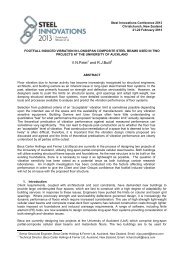Environmental Impacts of Multi-Storey Buildings Using Different ...
Environmental Impacts of Multi-Storey Buildings Using Different ...
Environmental Impacts of Multi-Storey Buildings Using Different ...
Create successful ePaper yourself
Turn your PDF publications into a flip-book with our unique Google optimized e-Paper software.
- 125 -building types, instead substituting timber-based products, such as Western Red Cedarlouvres and pine cladding.The main impact contributors for all building in terms <strong>of</strong> building components were thosewhich contained relatively large quantities <strong>of</strong> aluminium (louvres and windows) and steel(structure).However, the above analysis refers to a scenario where all the demolition materials are placedin landfill at the end <strong>of</strong> the 60 year lifetime <strong>of</strong> the building (and some <strong>of</strong> the materials areconsidered to decompose to methane which is released back to the atmosphere).A very different result is seen where materials are either recycled or emissions <strong>of</strong> gases backto the atmosphere at the end-<strong>of</strong>-life are prevented or those gases are used to displace the use<strong>of</strong> other fossil fuels.• What is the influence <strong>of</strong> construction materials on the maintenance relatedembodied energy and GWP <strong>of</strong> buildings?Maintenance related embodied energy and GWP <strong>of</strong> the buildings over the 60 year lifetimecontributed relatively minor environmental impacts compared to the initial embodied energyand GWP (building maintenance contributes only around 1 – 2 % to the total impacts (Tables10.1 and 10.2) and between 12 % (Steel building) and 21 % (TimberPlus) <strong>of</strong> initial embodiedenergy). However, there were noticeable differences, in maintenance impacts, betweenbuilding types and building components.The Steel building had the greatest maintenance related impacts, whereas TimberPlus had thesmallest. Fewer materials were required to maintain the TimberPlus building. Western redcedar, which lasts 60+ years, was used for louvres, balustrades, and reveals. These structuresdo not require replacement, resulting in a reduced overall impact for the TimberPlus building.The building components that required the most maintenance, with the largest contribution tototal maintenance related impact, were the windows. This is indicative <strong>of</strong> the large quantity <strong>of</strong>aluminium required in the maintenance <strong>of</strong> the frames. The exception is TimberPlus which hadthe lowest impact because the aluminium components <strong>of</strong> the windows were replaced withWestern Red Cedar.A well designed and constructed building, with low maintenance related embodied energywill decreases the overall life cycle impacts.
















